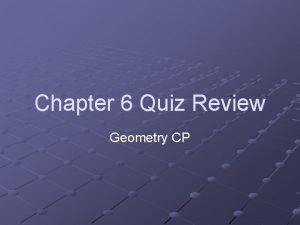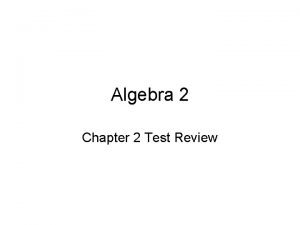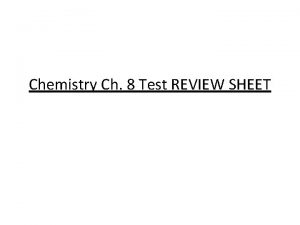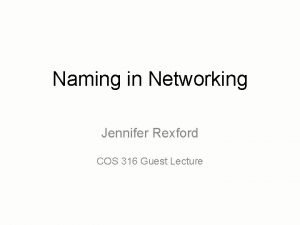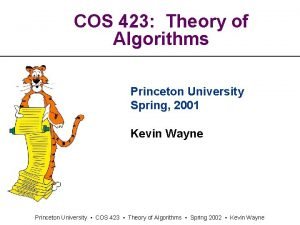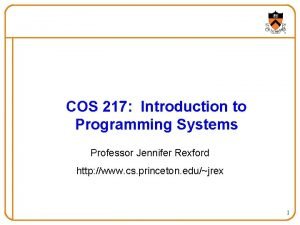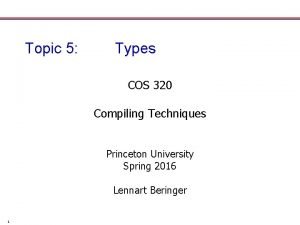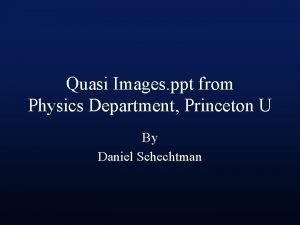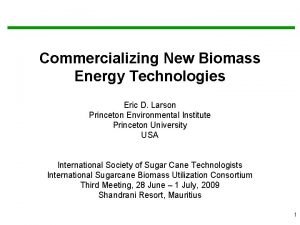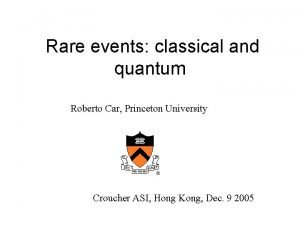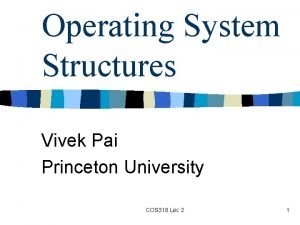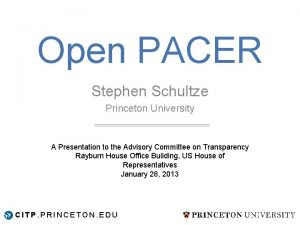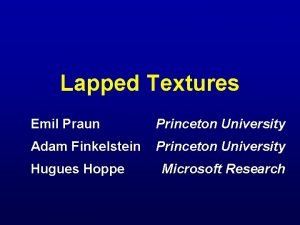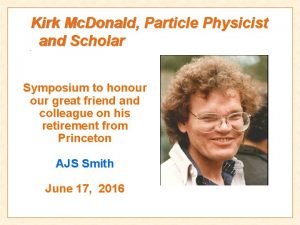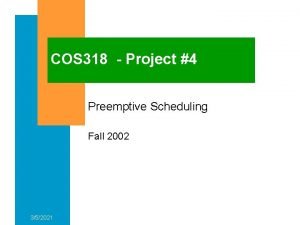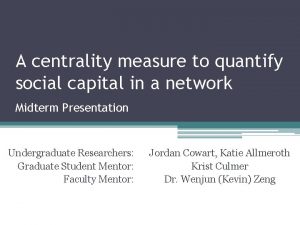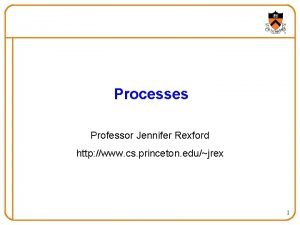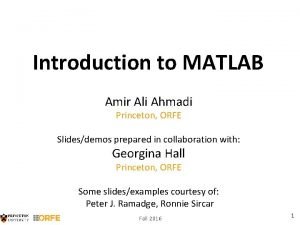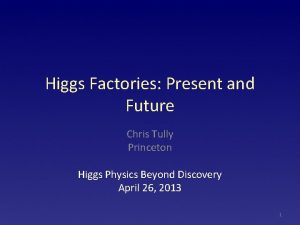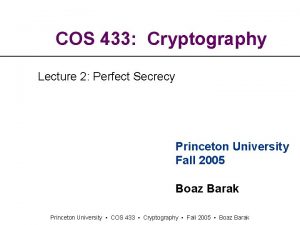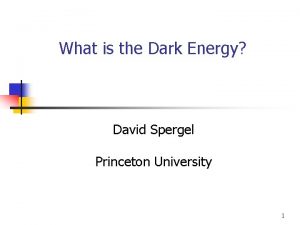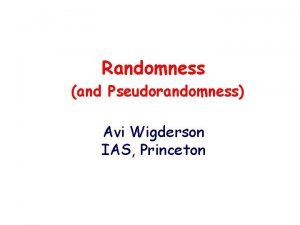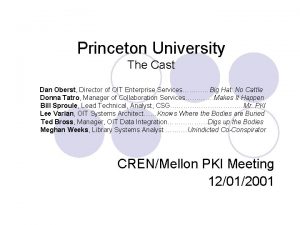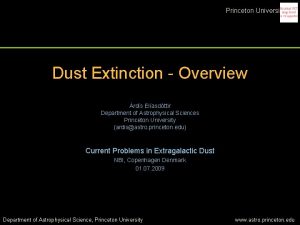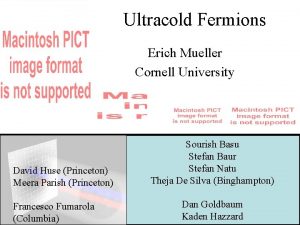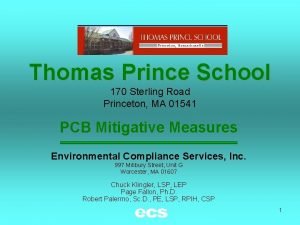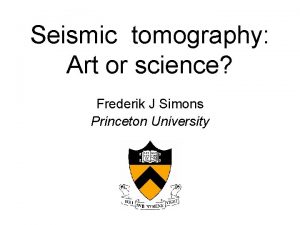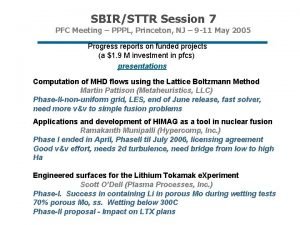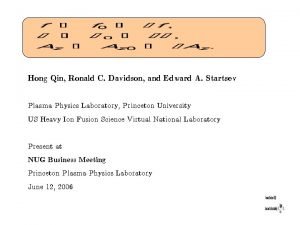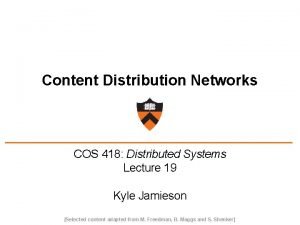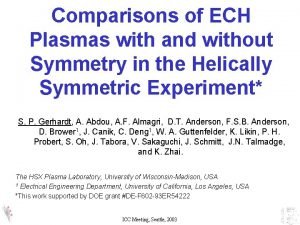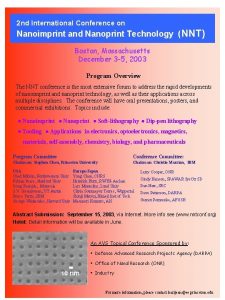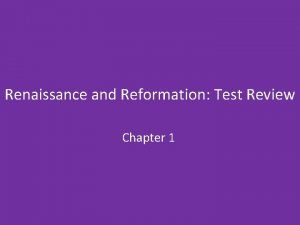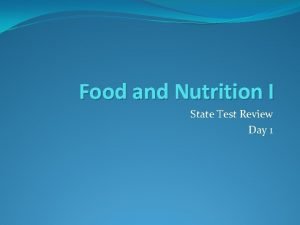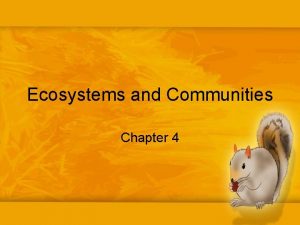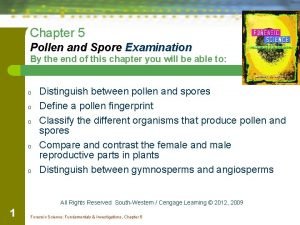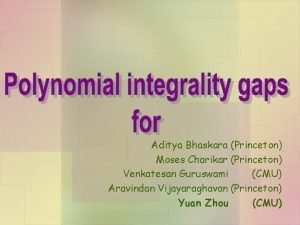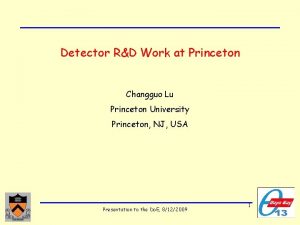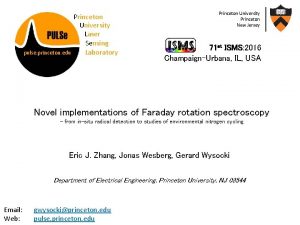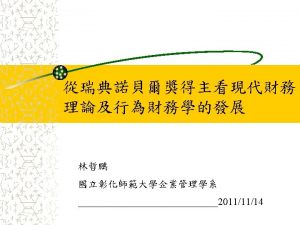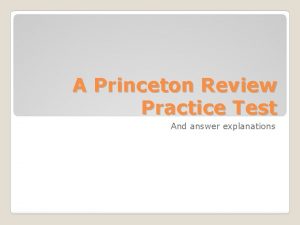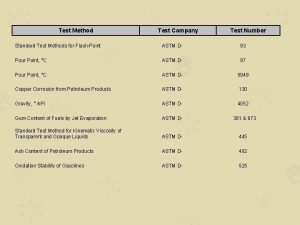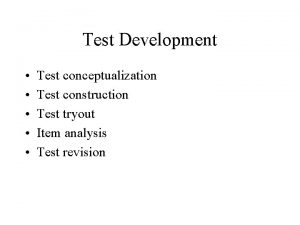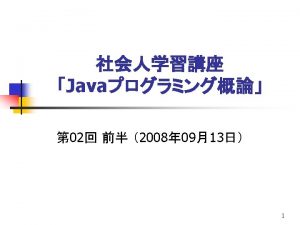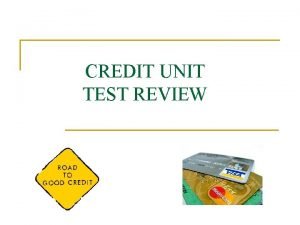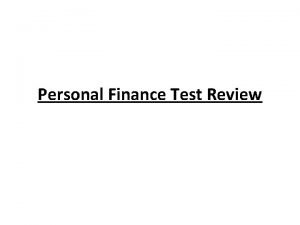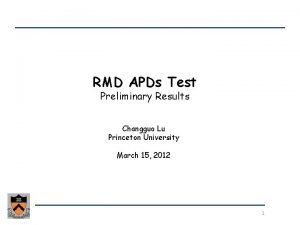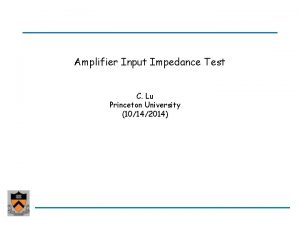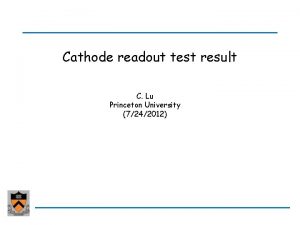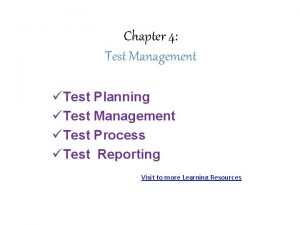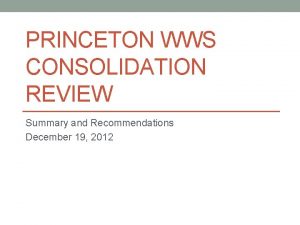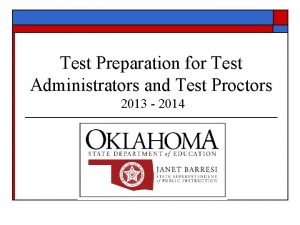Chapter 12 in test and Princeton Review 1




























![First-Order Reactions A k= product D[A] rate = Dt rate M/s = = 1/s First-Order Reactions A k= product D[A] rate = Dt rate M/s = = 1/s](https://slidetodoc.com/presentation_image_h/01cb167853c438875f29a9fa50812d12/image-29.jpg)



![First-order reaction A product # of half-lives [A] = [A]0/n 1 2 2 4 First-order reaction A product # of half-lives [A] = [A]0/n 1 2 2 4](https://slidetodoc.com/presentation_image_h/01cb167853c438875f29a9fa50812d12/image-33.jpg)

![Second-Order Reactions A product D[A] rate = Dt rate M/s = = 1/M • Second-Order Reactions A product D[A] rate = Dt rate M/s = = 1/M •](https://slidetodoc.com/presentation_image_h/01cb167853c438875f29a9fa50812d12/image-35.jpg)
![Zero-Order Reactions A product D[A] rate = Dt D[A] =k Dt rate = M/s Zero-Order Reactions A product D[A] rate = Dt D[A] =k Dt rate = M/s](https://slidetodoc.com/presentation_image_h/01cb167853c438875f29a9fa50812d12/image-36.jpg)

![Reaction order • rate = k [S 2 O 82 -]1 [I-]1 • [S Reaction order • rate = k [S 2 O 82 -]1 [I-]1 • [S](https://slidetodoc.com/presentation_image_h/01cb167853c438875f29a9fa50812d12/image-38.jpg)

![1. 1 st order ln[A]-ln[Af] =-kt ln[1. 6]-ln 2. 0 =-k 5 K = 1. 1 st order ln[A]-ln[Af] =-kt ln[1. 6]-ln 2. 0 =-k 5 K =](https://slidetodoc.com/presentation_image_h/01cb167853c438875f29a9fa50812d12/image-40.jpg)





![FACTORS THAT INFLUENCE NUMBER OF COLLISIONS • Concentration of reactants – As [reactants] ↑ FACTORS THAT INFLUENCE NUMBER OF COLLISIONS • Concentration of reactants – As [reactants] ↑](https://slidetodoc.com/presentation_image_h/01cb167853c438875f29a9fa50812d12/image-46.jpg)








![Try one 2 A+2 B C + D 1. 2. 3. Rate = k[A]2[B] Try one 2 A+2 B C + D 1. 2. 3. Rate = k[A]2[B]](https://slidetodoc.com/presentation_image_h/01cb167853c438875f29a9fa50812d12/image-55.jpg)
![AP Question The rate law for the overall reaction below is: Rate = k[NO] AP Question The rate law for the overall reaction below is: Rate = k[NO]](https://slidetodoc.com/presentation_image_h/01cb167853c438875f29a9fa50812d12/image-56.jpg)
![The rate law for the overall reaction below is: Rate = k[NO] + [Cl The rate law for the overall reaction below is: Rate = k[NO] + [Cl](https://slidetodoc.com/presentation_image_h/01cb167853c438875f29a9fa50812d12/image-57.jpg)
![The rate law for the overall reaction below is: Rate = k[NO] + [Cl The rate law for the overall reaction below is: Rate = k[NO] + [Cl](https://slidetodoc.com/presentation_image_h/01cb167853c438875f29a9fa50812d12/image-58.jpg)


- Slides: 60

• Chapter 12 in test and Princeton Review 1

KINETICS • The area of chemistry concerned with the rates at which chemical reactions occur. • How fast are reactants turning into products and visa versa. 2

Time it Takes to build a brick wall • • 1. Pick up bricks 2. deliver bricks 3. unload bricks 4. build wall 3

REACTION RATE • The change of the concentration of reactants or products over time. • Usually measured in M/sec. 4

4 MAJOR FACTORS THAT AFFECT REACTION RATE • Concentration of reactants • Concentration of a catalyst • Temperature • Surface area of a solid reactant or catalyst 5

CONCENTRATION OF REACTANTS • The rate of most reactions increases when the concentration of a reactant is increased. 6

Catalysts • Increases the rate of the reaction with out being consumed in the process. • They do not appear in the balance equation • They are necessary for some reactions to even occur • Increase rate of reaction by providing an alternative pathway for the reaction to occur with a lower activation energy. 7

uncatalyzed Ea Ea ΔH ΔH for both reactions are 15 k. J (ΔH is a state function and INDEPENDENT of pathway) Ea is pathway DEPENDENT and is different for both reactions. 8

CONCENTRATION OF A CATALYST • The rate of a chemical reaction increases with the concentration of a positive catalyst. Not all catalysts are created equal some can boost one reaction and hinder another. 9

TEMPERATURE • Generally speaking, reaction rate increases as temperature increases. • Think Kinetic Molecular Theory 10

SURFACE AREA OF A SOLID REACTANT OR CATALYST • If a reaction involves a solid with a gas or liquid, the rate of reaction increases as the surface area increases. 11

EXPRESSING AVERAGE REACTION RATE WITH RESPECT TO REACTANTS • I- (aq) + Cl. O- (aq) Cl- (aq) + IO- (aq) • Since the concentration of a reactant (I- (aq)) decreases with time (i. e. its consumed by the reaction), if we express the reaction rate with respect to a reactant, Avg rate = - ∆ [ I- ] /∆ time 12

EXPRESSING AVERAGE REACTION RATE WITH RESPECT TO PRODUCTS • I- (aq) + Cl. O- (aq) Cl- (aq) + IO- (aq) • Since the concentration of products increases with time (i. e. they are formed) Avg rate = ∆ [IO-] / ∆ t 13

14

REACTION RATES AND STOICHIOMETRY • Given the following data, calculate the average rate of reaction in (M/s) with respect to C 4 H 9 Cl, for the 1 st 50 seconds. • -1. 9 x 10 -4 M/s TIME (s) 0 [C 4 H 9 Cl] (M) 0. 1000 50. 0905 100. 0820 150. 0741 200. 0671 300. 0549 15

REACTION RATES AND STOICHIOMETRY • Calculate the average reaction rate, with respect to C 4 H 9 Cl, for the 2 nd 50 seconds. • -1. 7 x 10 -4 M/s TIME (s) 0 [C 4 H 9 Cl] (M) 0. 1000 50. 0905 100. 0820 150. 0741 200. 0671 300. 0549 16

INSTANTANEOUS RATE OF RXN • In the previous problem, we have calculated the average reaction rate during a specified period of time. • If we plot [reactant] on y-axis and time on the xaxis we can determine the instantaneous rate of rxn. • Draw a straight line tangent that touches the curve at the pt. of interest (specified time). The slopes of tangents give the instantaneous rates at those times. (this is calculus) 17

Instantaneous Rate 18

19

RXN RATES AND STOICHIOMETRY • Because the amounts of products and reactants are related by stoichiometry, any substance in the reaction can be used to express the rate of reaction in relationship to time. • rate = 1/[A]/∆ t 20

RXN RATES AND STOICHIOMETRY • In general, for the reaction a. A + b. B c. C + d. D Note that reactants are disappearing • Rate = (- 1/a)(Δ[A]/Δt) = (-1/b)(Δ[B]/Δt) = (1/c)(Δ[C]/Δt) = (1/d)(Δ[D]/Δt) • Tells us how the rate of the reaction depends on concentration 21

RXN RATES AND STOICHIOMETRY • 2 O 3 (g) 3 O 2 (g) • How is the rate of disappearance of ozone related to the rate of appearance of oxygen in the above? • Rate =(-1/ 2) (∆[O 3]/∆t) = (1/ 3) (∆[O 2] ]/∆t) Disappearance Appearance 22

RXN RATES AND STOICHIOMETRY • 2 O 3 (g) 3 O 2 (g) • If the rate of appearance of oxygen (O 2 ) is 6. 0 x 10 -5 M at a particular instant, what is the value of the rate of disappearance of ozone (O 3 ) at this same time? 23

RXN RATES AND STOICHIOMETRY 2 O 3 (g) 3 O 2 (g) • Rate = (-1/2)(∆[O 3]/∆t) = (1/3)(∆[O 2]/∆t) • - ∆ [O 3]/∆t = (2/3)(∆[O 2]/∆t) • (2/3)(6. 0 x 10 -5 M/s) = - ∆[O 3] • 4. 0 x 10 -5 M/s 24

The Rate Law The rate law expresses the relationship of the rate of a reaction to the rate constant (k) and the concentrations of the reactants raised to some powers. a. A + b. B c. C + d. D Rate = k [A]x[B]y reaction is xth order in A reaction is yth order in B reaction is (x +y)th order overall *The greater the value of the exponent the greater the change in concentration of that reactant 25 13. 2

F 2 (g) + 2 Cl. O 2 (g) 2 FCl. O 2 (g) rate = k [F 2]x[Cl. O 2]y Double [F 2] with [Cl. O 2] constant Rate doubles [2] x = 2 Conc initial rate x=1 order of rxn Quadruple [Cl. O 2] with [F 2] constant rate = k [F 2][Cl. O 2] Rate quadruples [4] y = 4 y =1 26 13. 2

Rate Laws • Rate laws are always determined experimentally. • • Reaction order is always defined in terms of reactant (not product) concentrations. The rate law of a reactant is not related to the stoichiometric coefficient of the reactant in the balanced chemical equation. • Tells us how the rate depends on concentration F 2 (g) + 2 Cl. O 2 (g) 2 FCl. O 2 (g) rate = k [F 2][Cl. O 2] 1 27 13. 2

Determine the rate law and calculate the rate constant (k) for the following reaction from the following data: S 2 O 82 - (aq) + 3 I- (aq) 2 SO 42 - (aq) + I 3 - (aq) Experiment [S 2 O 82 -] [I-] Initial Rate (M/s) 1 0. 08 0. 034 2. 2 x 10 -4 2 0. 08 0. 017 1. 1 x 10 -4 3 0. 16 0. 017 2. 2 x 10 -4 rate = k [S 2 O 82 -]x[I-]y y=1 x=1 rate = k [S 2 O 82 -][I-] Double [I-], rate doubles (experiment 1 & 2) Double [S 2 O 82 -], rate doubles (experiment 2 & 3) 2. 2 x 10 -4 M/s rate k= = = 0. 08/M • s 2[S 2 O 8 ][I ] (0. 08 M)(0. 034 M) 28 13. 2
![FirstOrder Reactions A k product DA rate Dt rate Ms 1s First-Order Reactions A k= product D[A] rate = Dt rate M/s = = 1/s](https://slidetodoc.com/presentation_image_h/01cb167853c438875f29a9fa50812d12/image-29.jpg)
First-Order Reactions A k= product D[A] rate = Dt rate M/s = = 1/s or s-1 M [A] rate = k [A] D[A] = k [A] Dt ln[A] = ln[A]0 - kt [A] is the concentration of A at any time t [A]0 is the concentration of A at time t=0 29 13. 3

2 N 2 O 5 4 NO 2 (g) + O 2 (g) 30 13. 3

The reaction 2 A B is first order in A with a rate constant of 2. 8 x 10 -2 s-1 at 800 C. How long will it take for A to decrease from 0. 88 M to 0. 14 M ? [A]0 = 0. 88 M ln[A] = ln[A]0 - kt [A] = 0. 14 M kt = ln[A]0 – ln[A] = t= k ln [A]0 [A] k ln = 0. 88 M 0. 14 M 2. 8 x 10 -2 s-1 = 66 s 31 13. 3

First-Order Reactions The half-life, t½, is the time required for the concentration of a reactant to decrease to half of its initial concentration. t½ = t when [A] = [A]0/2 ln t½ = [A]0/2 k ln 2 0. 693 = = k k What is the half-life of N 2 O 5 if it decomposes with a rate constant of 5. 7 x 10 -4 s-1? 0. 693 t½ = ln 2 = = 1200 s = 20 minutes -4 -1 k 5. 7 x 10 s How do you know decomposition is first order? units of k (s-1) 32 13. 3
![Firstorder reaction A product of halflives A A0n 1 2 2 4 First-order reaction A product # of half-lives [A] = [A]0/n 1 2 2 4](https://slidetodoc.com/presentation_image_h/01cb167853c438875f29a9fa50812d12/image-33.jpg)
First-order reaction A product # of half-lives [A] = [A]0/n 1 2 2 4 3 8 4 16 33 13. 3

AP Add in TOYO • Half Life • Radioactive Decay • Balancing Nuclear Reactions 34
![SecondOrder Reactions A product DA rate Dt rate Ms 1M Second-Order Reactions A product D[A] rate = Dt rate M/s = = 1/M •](https://slidetodoc.com/presentation_image_h/01cb167853c438875f29a9fa50812d12/image-35.jpg)
Second-Order Reactions A product D[A] rate = Dt rate M/s = = 1/M • s k= 2 2 M [A] 1 1 = + kt [A]0 rate = k [A]2 D[A] = k [A]2 Dt [A] is the concentration of A at any time t [A]0 is the concentration of A at time t=0 t½ = t when [A] = [A]0/2 1 t½ = k[A]0 35 13. 3
![ZeroOrder Reactions A product DA rate Dt DA k Dt rate Ms Zero-Order Reactions A product D[A] rate = Dt D[A] =k Dt rate = M/s](https://slidetodoc.com/presentation_image_h/01cb167853c438875f29a9fa50812d12/image-36.jpg)
Zero-Order Reactions A product D[A] rate = Dt D[A] =k Dt rate = M/s k= 0 [A] = [A]0 - kt rate = k [A]0 = k [A] is the concentration of A at any time t [A]0 is the concentration of A at time t=0 t½ = t when [A] = [A]0/2 [A]0 t½ = 2 k 36 13. 3

Summary of the Kinetics of Zero-Order, First-Order and Second-Order Reactions Order 0 1 Rate Law rate = k [A] Concentration-Time Equation [A] = [A]0 – kt Units for k M/s 2 rate = k t½ = [A]0 2 k ln[A] = ln[A]0 – kt t½ = ln 2 k 1 1 = + kt [A]0 1 t½ = k[A]0 Units for k s-1 [A]2 Half-Life Units for k 1/M • s 37 13. 3
![Reaction order rate k S 2 O 82 1 I1 S Reaction order • rate = k [S 2 O 82 -]1 [I-]1 • [S](https://slidetodoc.com/presentation_image_h/01cb167853c438875f29a9fa50812d12/image-38.jpg)
Reaction order • rate = k [S 2 O 82 -]1 [I-]1 • [S 2 O 82 -]1 = first order • [I-] 1 = first order • 1+1 = 2 = second order over all 38

Sample AP Problem Series 1. Find k 2. What is concentration after 20 mins 3. What is the half life for the reaction [A] M 2. 0 1. 6 1. 2 Time min 0 5 10 Given this is a first order reaction (we can find this… how? ) 39
![1 1 st order lnAlnAf kt ln1 6ln 2 0 k 5 K 1. 1 st order ln[A]-ln[Af] =-kt ln[1. 6]-ln 2. 0 =-k 5 K =](https://slidetodoc.com/presentation_image_h/01cb167853c438875f29a9fa50812d12/image-40.jpg)
1. 1 st order ln[A]-ln[Af] =-kt ln[1. 6]-ln 2. 0 =-k 5 K = 0. 045 1/min 2. Ln[A]-ln[2. 0]=-0. 045*20 [A] = e-0. 21 = 0. 81 M 1 st 3. Half life order = ln 2/K = 0. 693/0. 0451/min = 15. 4 min [A] M Time min 2. 0 0 1. 6 5 1. 2 10 40

Homework • Pg 602 11, 14, 19 41

COLLISION THEORY OF KINETICS • Molecules must collide with sufficient energy (activation energy, Ea) and correct orientation relative to each other (steric factor) for a reaction to occur. 42

43

ACTIVATION ENERGY (Ea) • The minimum amount of energy needed to start a chemical reaction. 44

A+B Exothermic Reaction + + AB C+D Endothermic Reaction The activation energy (Ea ) is the minimum amount of energy required to initiate a chemical reaction. 45 13. 4
![FACTORS THAT INFLUENCE NUMBER OF COLLISIONS Concentration of reactants As reactants FACTORS THAT INFLUENCE NUMBER OF COLLISIONS • Concentration of reactants – As [reactants] ↑](https://slidetodoc.com/presentation_image_h/01cb167853c438875f29a9fa50812d12/image-46.jpg)
FACTORS THAT INFLUENCE NUMBER OF COLLISIONS • Concentration of reactants – As [reactants] ↑ rxn rate ↑ due to an ↑ in probability a collision will occur • Temperature at which the reaction occurs. – ↑ Temp = ↑ KE of molecule ↑ probability of having the right Ea for a rxn to occur – So this will increase k and Rate! 46

Changes in reaction rate • Rxn rate will ↓ over time as reactants are used up. 47

Temperature Dependence of the Rate Constant Ea 1 lnk = + ln. A R T Ea is the activation energy (J/mol) R is the gas constant (8. 314 J/K • mol) T is the absolute temperature Slope = Ea/R A is the frequency factor *****Rate constant k increases as T increases. ***** 48 13. 4

Reaction Mechanisms The overall progress of a chemical reaction can be represented at the molecular level by a series of simple elementary steps or elementary reactions. (Remember Hess’s Law) The sequence of elementary steps that leads to product formation is the reaction mechanism. 2 NO (g) + O 2 (g) 2 NO 2 (g) N 2 O 2 is detected during the reaction! Elementary step: NO + NO N 2 O 2 + Elementary step: N 2 O 2 + O 2 2 NO 2 Overall reaction: 2 NO + O 2 2 NO 2 49 13. 5

2 NO (g) + O 2 (g) 2 NO 2 (g) 50 13. 5

Intermediates are species that appear in a reaction mechanism but not in the overall balanced equation. An intermediate is always formed in an early elementary step and consumed in a later elementary step. Elementary step: NO + NO N 2 O 2 + Elementary step: N 2 O 2 + O 2 2 NO 2 Overall reaction: 2 NO + O 2 2 NO 2 The molecularity of a reaction is the number of molecules reacting in an elementary step. • Unimolecular reaction – elementary step with 1 molecule • Bimolecular reaction – elementary step with 2 molecules • Termolecular reaction – elementary step with 3 molecules 51 13. 5

Rate Laws and Elementary Steps ( add to sheet) Unimolecular reaction A products rate = k [A] Bimolecular reaction A+B products rate = k [A][B] Bimolecular reaction A+A products rate = k [A]2 Writing plausible reaction mechanisms: • The sum of the elementary steps must give the overall balanced equation for the reaction. • The rate-determining step should predict the same rate law that is determined experimentally. The rate-determining step is the slowest step in the sequence of steps leading to product formation. 52 13. 5

Sequence of Steps in Studying a Reaction Mechanism 53 13. 5

The experimental rate law for the reaction between NO 2 and CO to produce NO and CO 2 is rate = k[NO 2]2. The reaction is believed to occur via two steps: Step 1: NO 2 + NO 2 NO + NO 3 Step 2: NO 3 + CO NO 2 + CO 2 What is the equation for the overall reaction? NO 2+ CO NO + CO 2 What is the intermediate? NO 3 What can you say about the relative rates of steps 1 and 2? rate = k[NO 2]2 is the rate law for step 1 so step 1 must be slower than step 2 54 13. 5
![Try one 2 A2 B C D 1 2 3 Rate kA2B Try one 2 A+2 B C + D 1. 2. 3. Rate = k[A]2[B]](https://slidetodoc.com/presentation_image_h/01cb167853c438875f29a9fa50812d12/image-55.jpg)
Try one 2 A+2 B C + D 1. 2. 3. Rate = k[A]2[B] A+A X fast X + B C+Y slow (rate determining step) Y +B –> D fast Prove the mechanism is constant with the rate law. Rate for line 2 = Rate = k[X][B] X is an intermediate (cancels out) X is really = to [A][A] or [A]2 for [X]. That gives Rate = k[A]2[B] 55
![AP Question The rate law for the overall reaction below is Rate kNO AP Question The rate law for the overall reaction below is: Rate = k[NO]](https://slidetodoc.com/presentation_image_h/01cb167853c438875f29a9fa50812d12/image-56.jpg)
AP Question The rate law for the overall reaction below is: Rate = k[NO] + [Cl 2] i. NO + Cl 2 NOCl 2 ii. NOCl 2 +NO 2 NOCl NO + Cl 2 2 NOCl 1. Is NOCl 2 an intermediate or a catalyst? 2. What step is faster? 3. What step determines the over all reaction rate and why? 56
![The rate law for the overall reaction below is Rate kNO Cl The rate law for the overall reaction below is: Rate = k[NO] + [Cl](https://slidetodoc.com/presentation_image_h/01cb167853c438875f29a9fa50812d12/image-57.jpg)
The rate law for the overall reaction below is: Rate = k[NO] + [Cl 2] i. NO + Cl 2 NOCl 2 ii. NOCl 2 +NO 2 NOCl NO + Cl 2 2 NOCl 1. Is NOCl 2 an intermediate or a catalyst? Intermediate because it is produced in one reaction and consumed in another. 57
![The rate law for the overall reaction below is Rate kNO Cl The rate law for the overall reaction below is: Rate = k[NO] + [Cl](https://slidetodoc.com/presentation_image_h/01cb167853c438875f29a9fa50812d12/image-58.jpg)
The rate law for the overall reaction below is: Rate = k[NO] + [Cl 2] i. NO + Cl 2 NOCl 2 ii. NOCl 2 +NO 2 NOCl NO + Cl 2 2 NOCl 2. What step is faster? Step ii 3. What step determines the over all reaction rate and why? Step i because it determines the rate law. NO + Cl 2 NOCl 2 Rate = k[NO] + [Cl 2] 58

A catalyst is a substance that increases the rate of a chemical reaction without itself being consumed. Ea k Uncatalyzed Catalyzed ratecatalyzed > rateuncatalyzed Ea‘ < Ea 59 13. 6

Homework Pg 602 21, 22, 23, 27 PR Problems – any 2 Essay – any 1 60
 Chapter review motion part a vocabulary review answer key
Chapter review motion part a vocabulary review answer key Algebra 2 unit test
Algebra 2 unit test Amit agarwal princeton
Amit agarwal princeton Iac princeton
Iac princeton Chapter 6 quiz 1 geometry
Chapter 6 quiz 1 geometry Algebra 1 chapter 2 review
Algebra 1 chapter 2 review Chapter 8 test review chemistry
Chapter 8 test review chemistry Pics princeton
Pics princeton Princeton cos 316
Princeton cos 316 Hantao ji
Hantao ji Cos 423
Cos 423 Princeton cos217
Princeton cos217 Cos 320 princeton
Cos 320 princeton Quasicrystals ppt
Quasicrystals ppt Eric larson princeton
Eric larson princeton Roberto car princeton
Roberto car princeton Princeton policy task force
Princeton policy task force Princeton university’s gerrymandering project
Princeton university’s gerrymandering project Cos princeton
Cos princeton Citp princeton
Citp princeton Gavin cook princeton
Gavin cook princeton Adam finkelstein princeton
Adam finkelstein princeton Kirk mcdonald physics
Kirk mcdonald physics Cos318 fall 2021
Cos318 fall 2021 Cs.princeton.edu
Cs.princeton.edu Tigerpay princeton
Tigerpay princeton Cs princeton
Cs princeton Business headshots princeton
Business headshots princeton Amir ali ahmadi
Amir ali ahmadi Chris tully princeton
Chris tully princeton Princeton cos
Princeton cos Measure h
Measure h Avi wigderson princeton
Avi wigderson princeton Dan oberst
Dan oberst Princeton
Princeton David huse princeton
David huse princeton Thomas prince school princeton ma
Thomas prince school princeton ma Frederik simons princeton
Frederik simons princeton Pfc princeton
Pfc princeton Ias princeton math
Ias princeton math Hong qin princeton
Hong qin princeton Cos 418
Cos 418 Princeton field-reversed configuration
Princeton field-reversed configuration Iadsr
Iadsr Chapter 6: career readiness
Chapter 6: career readiness Uncontrollable spending ap gov
Uncontrollable spending ap gov Nader amin-salehi
Nader amin-salehi Traditional and systematic review venn diagram
Traditional and systematic review venn diagram Narrative review vs systematic review
Narrative review vs systematic review Romeo and juliet test review
Romeo and juliet test review Renaissance and reformation test
Renaissance and reformation test Romeo and juliet test
Romeo and juliet test Endosperm of wheat
Endosperm of wheat Chapter 14 review acids and bases section 1
Chapter 14 review acids and bases section 1 Geometry chapter 12
Geometry chapter 12 Chapter 4 ecosystems and communities vocabulary review
Chapter 4 ecosystems and communities vocabulary review Chapter 8 review describing chemical reactions
Chapter 8 review describing chemical reactions Retention hyperkeratosis dermnet
Retention hyperkeratosis dermnet Balancing equations chapter 8
Balancing equations chapter 8 Chapter 7 review chemical formulas and chemical compounds
Chapter 7 review chemical formulas and chemical compounds Chapter 5 pollen and spore examination review answers
Chapter 5 pollen and spore examination review answers




